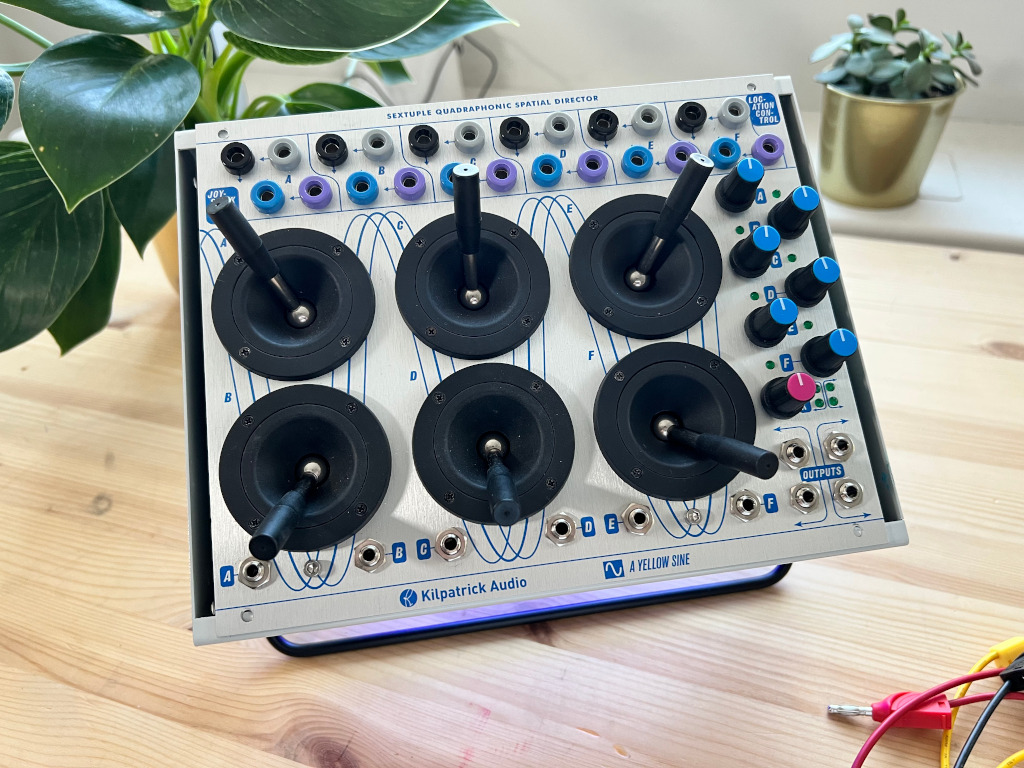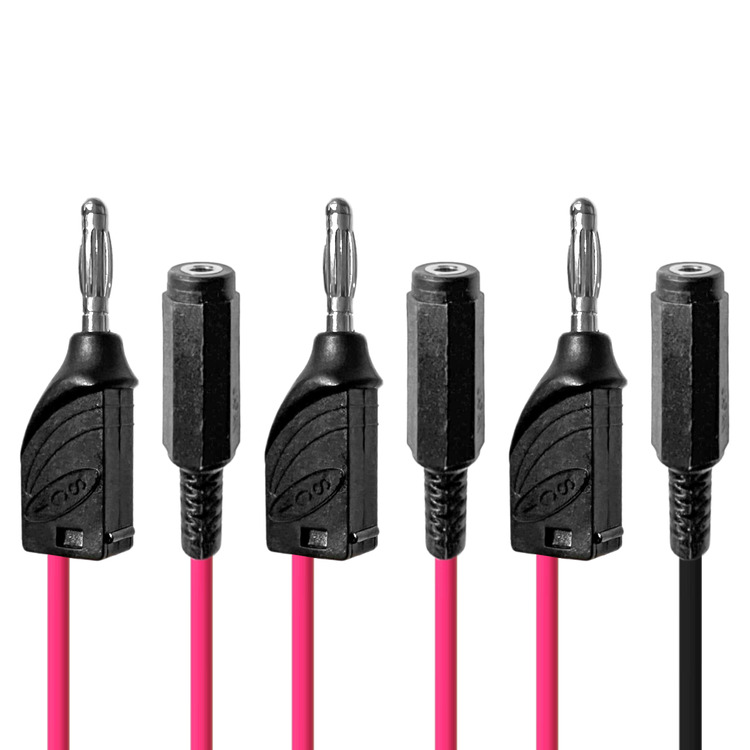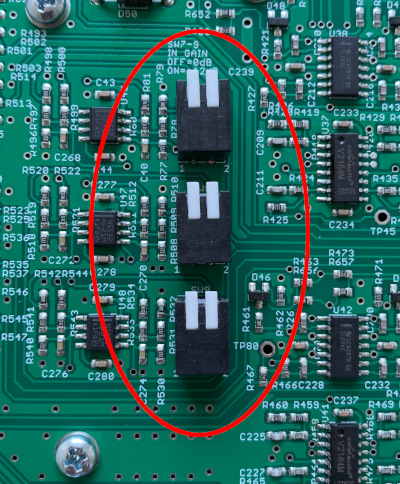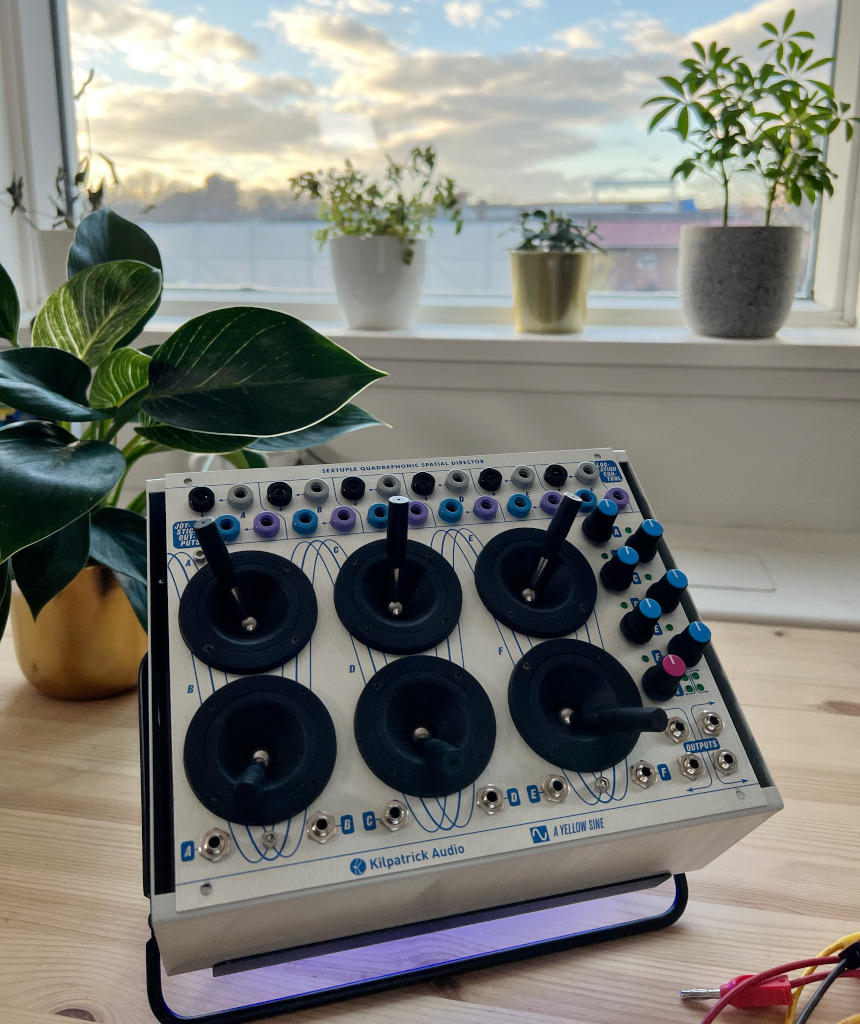
Sextuple Quadraphonic Spatial Director
Six-input Quadraphonic Mixer and Joystick Controller
Two-space Buchla-compatible module
Price and Availability | Accessories | Videos | Setup and Usage Tips
The SQSD combines six joysticks capable of generating control voltage with a six-input equal-power panning mixer, allowing for intuitive and fun direction of spatial sound in both stereo and quadraphonic speaker configurations. It's the ultimate hands-on mixer for electronic musicians looking to take their performances to the next level.
The SQSD is made possible with a collaboration between Kilpatrick Audio and A Yellow Sine. The team consists of:
- Patrick McMaster - Composer, performer and electronic music wizard of A Yellow Sine
- Andrew Kilpatrick - Conductor of Electricity and founder of Kilpatrick Audio
Joystick Controller
Each of the six joysticks generate two control voltage signals: one for each axis of motion. These CV outputs can modulate parameters on compatible voltage-controlled electronic music equipment. Using the joysticks to control the location of a sound source is intuitive and fun, and the SQSD makes this easy by incorporating six channels of quadraphonic panning.
Quadraphonic Panning
Quadraphonic sound involves the use of four speakers to create an immersive listening experience in which sounds can move around the listener. It's the most accessible form of what's called spatial or surround sound since it only requires four speakers.
Two dedicated location control inputs are available for each of the six channels. You can connect control voltage signals from a sequencer, envelope or LFO to these inputs, but the joysticks make quad panning quick and easy. The twelve joystick CV outputs and location control inputs are grouped together, and can be easily patched with shorting bars. Convenient DIP switches on the back of the unit normalize these connections without the need for any patching.
Mixer
Up to six channels of sound can become part of the quadraphonic or stereo spatial direction, with each channel having its own dedicated level control and LED indicator light. There's a main mix output control as well with LEDs for each of the four outputs.
Notes from the Spatial Direction Coordinator
The stackable nature of banana cables means that a single joystick can perform many actions. By patching the outputs from one to the location controls of several channels, a single joystick can spatialize multiple sound sources. Connecting a joystick output to both the location control input and some other parameter in your system can create a linking of the sound's movement with another of its features.
One example of this is to send the vertical axis of a joystick to both the location control and the mix control of a reverb effect. When the sound moves away from one end of the room it becomes more reverberated. You could additionally use an inverted version of this control voltage signal to control the frequency cutoff of a lowpass filter, so as the sound source moves away it contains less frequency content as well, which combined with the increase in reverb amount would simulate natural acoustic properties of distance.
A simple stereo setup where the horizontal axis controls panning and the vertical axis controls amplitude or volume is quite intuitive. The horizontal axis might control the index or amount of frequency modulation applied to an oscillator, while the vertical axis controls the frequency of the modulating oscillator.
The four outputs of the SQSD don't necessarily have to connect to speakers either. Using the joysticks to crossfade different sound source inputs allows for complex signal blending. A patch with just four oscillators signals and two control voltage inverters will allow the SQSD to use the principles of vector synthesis, uniquely providing simultaneous access to four different waveform blends at the output mixer.
Features and Specs
- Two-space (4U) Buchla-compatible module
- Low-noise CV and audio signal path
- No digital circuitry used - 100% analog design!
- Six channel quadraphonic mixer with voltage control
- Six joysticks with X and Y outputs: 0-10V = L>R, 0-10V = S>F
- Six quadraphonic constant-power directional panners with voltage control
- Internal normalling switches to connect joysticks to directional panners
- Directional panners can accept -5V to +5V or 0-10V (DIP switch selectable)
- Audio inputs support >10Vpk (>20dBu) max input level
- Audio inputs have 0dB/+10dB selectable gain (DIP switch selectable)
- Audio outputs support >10Vpk (>20dBu) max output level
- Audio input and output signal level indicators (-16dB min. indication)
- Audio jacks are genuine Switchcraft 3.5mm minijack (Tini-Jax® available by special order)
- Banana jacks use Johnson / Cinch banana connectors
- High-quality brushed anodized aluminum panel
- Requires +15V at 475mA and -15V at 375mA
- Dimensions: 8.5" x 7" x 1.9" max depth
- Warranty: 1 year
- Completely engineered, assembled and tested by Kilpatrick Audio in Canada
- Optional: Two-space powered Buchla-compatible enclosure available - designed and built by Kilpatrick Audio
Price and Availability
Price: $1399 USD ($1749 USD with powered boat) - Minijack version
This limited edition product is available only directly from Kilpatrick Audio.
Accessories



Banana to Minijack Adapter Kit
This kit allows you to connect your SQSD or other banana gear to gear that uses minijacks for control voltages. The SQSD has internal settings to choose the CV control input voltage range to make it easier to use with Eurorack and other synths. Available in three colour combinations!
Each kit includes:
- 5x banana (M) to minijack (F) signal adapters (150mm / 6")
- 1x banana (M) to minijack (F) ground adapter (150mm / 6")
Only: $44.99 USD
Intro Video
Setup and Usage Tips
Setting Audio Input Gain

The audio input gain for each of the six inputs can be adjusted between 0dB (default) and +12dB which allows lower level signals to be used. If you do not see any input LED indication when using loud signals from your signal source should consider using the +12dB gain mode. To enable gain for each channel press down the DIP switch corresponding to the channel you wish to adjust.
Normalling Joystick / Directional Inputs

The joysticks on the SQSD come set-up pre-normalled. This means that each of the joysticks A-F are routed to the corresponding directional inputs. No jumpers need to be added to the front panel banana jacks to use the SQSD. However you can disable the normalling on a per-input basis if you want to feed external CV signals into the directional inputs. To disable the normalling for a channel move the corresponding DIP switch to the up (off) position. (towards the bottom of the image) The image above shows channel F on the left, and channel A on the right.
Note: The joystick output always create a 0-10V output range and can be used to control external gear even when normalled or connected to the directional inputs.
Setting CV Input Range

The directional inputs are set-up by default to accept an input range from 0 to +10V from the joysticks. If you wish to use the directional inputs from synths that use bipolar voltages, the CV inputs can be adjusted to use a -5V to +5V range instead by turning the corresponding DIP switch to the up (off) position. The image above shows channel F on the left, and channel A on the right.
Note: When using external CV inputs please disable the internal normalling jumpers connecting the joysticks to the CV inputs.
Reference Voltage and Offset Calibration
Each SQSD comes pre-calibrated from our workshop. Calibrating the reference voltages and offset adjustments requires a high-precision voltmeter, audio test tone generator and audio level metering with a range of at least 90dB. Please contact us if you require assistance in doing the calibration.


